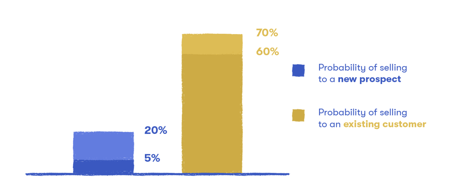An eCommerce Seller's Guide to Upselling & Cross-Selling Online
How Are Upselling and Cross-Selling Different?
Upselling and cross-selling are both sales techniques used by businesses to increase revenue from customers, but they differ in their approach and objective.
Upselling is the practice of encouraging a customer to buy a more expensive or premium version of a product or service they are already considering. The goal of upselling is to increase the overall value of the sale by convincing the customer to purchase a higher-priced option. In an upsell situation, the salesperson or business representative will present the customer with an option that is better, bigger, or more comprehensive than the original product they were considering. This could involve recommending a higher-end model of a product, or suggesting additional features or services that would enhance the customer's experience. For example, a customer who is interested in buying a standard laptop may be upsold to a premium laptop with more features and higher specifications. Effective upselling requires a good understanding of the customer's needs and preferences, and the ability to communicate the value of the upsell option in a way that resonates with the customer.
Cross-selling, on the other hand, is the practice of offering additional products or services that complement or supplement the item a customer is already purchasing. The goal of cross-selling is to increase the total purchase amount by suggesting related or complementary products. In a cross-selling situation, the salesperson or business representative will present the customer with additional products or services that would enhance the customer's experience with the item they are already purchasing. For example, if a customer has a laptop in their cart, the website algorithm might then suggest a laptop case, a wireless mouse, or other accessories that would be useful for the customer to add to their purchase. Effective cross-selling requires a good understanding of the customer's needs and preferences, and the ability to suggest products or services that are relevant and useful to the customer.
When done well, upselling and cross-selling can be win-win situations for both the business and customer because the customer gets either a better product or additional products that enhance their experience, and the business increases its revenue.
How to Upsell & Cross-Sell on Marketplaces
- Offer Product Bundles: Create product bundles that offer a discount when multiple items are purchased together. This can encourage customers to buy more than they originally intended, increasing the average order value.
- Create Urgency: Use limited time offers, countdown timers or limited stock notices to create a sense of urgency in customers and encourage them to make a purchase decision.
- Provide Relevant Product Recommendations: Use algorithms to recommend related or complementary products to customers based on their browsing and purchase history. This can help customers discover products they might not have found otherwise, and increase the average order value.
- Provide Product Comparisons: Help customers make informed purchase decisions by providing comparisons between similar products. This can help customers understand the differences and choose the product that best fits their needs.
- Personalize Communication: Use customer data to personalize your communication with customers and tailor your offers based on their interests and purchase history. By tailoring the offer to the customer's preferences and needs, the chances of a successful upsell or cross-sell increase. Additionally, the timing of the offer is also important. The offer should be presented at the right time in the customer journey, such as after the customer has expressed interest in a particular product or service.
- Provide Excellent Customer Service: Respond to customer inquiries quickly and efficiently. Satisfied customers are more likely to purchase from you again and recommend your business to others.
Why is it Important for Online (and Offline) Businesses to Upsell and Cross-Sell?
- Increased Revenue: Both techniques are effective ways for businesses to increase their revenue by encouraging customers to spend more money. By offering more expensive or complementary products, businesses can boost their sales and profitability.
- Improved Customer Experience: Upselling and cross-selling can also improve the customer experience by offering customers additional products or services that enhance their original purchase. This can help build customer loyalty and increase customer satisfaction.
- Competitive Advantage: By offering upsell and cross-sell options, businesses can differentiate themselves from their competitors and stand out in a crowded market. This can help businesses attract and retain customers.
- Cost-effective: Upselling and cross-selling can be cost-effective ways to increase revenue, as they
 don't require the acquisition of new customers. Instead, businesses can leverage their existing customer base to increase their sales. In fact, statistics show that on average, the chances of selling to a new customer are between 5 and 20%, while the likelihood of selling to an existing customer is between 60 and 70%, shown in the graph to the right.
don't require the acquisition of new customers. Instead, businesses can leverage their existing customer base to increase their sales. In fact, statistics show that on average, the chances of selling to a new customer are between 5 and 20%, while the likelihood of selling to an existing customer is between 60 and 70%, shown in the graph to the right.
Overall, upselling and cross-selling are important techniques for businesses to maximize their sales. These techniques can be effective ways for businesses to increase revenue and profitability, while also improving the customer experience and building customer loyalty.
More About aiCommerce
aiCommerce is a global digital marketing agency with a focus on retail and eCommerce marketplaces. aiCommerce is primed with decades of digital marketing experience and backed by our 90-day grow and know guarantee, we can help your brand grow across eCommerce channels to gain brand awareness and increase sales. Now is the perfect time to utilize our eCommerce experts to help grow your business. Click the button below to jumpstart your eCommerce growth!




